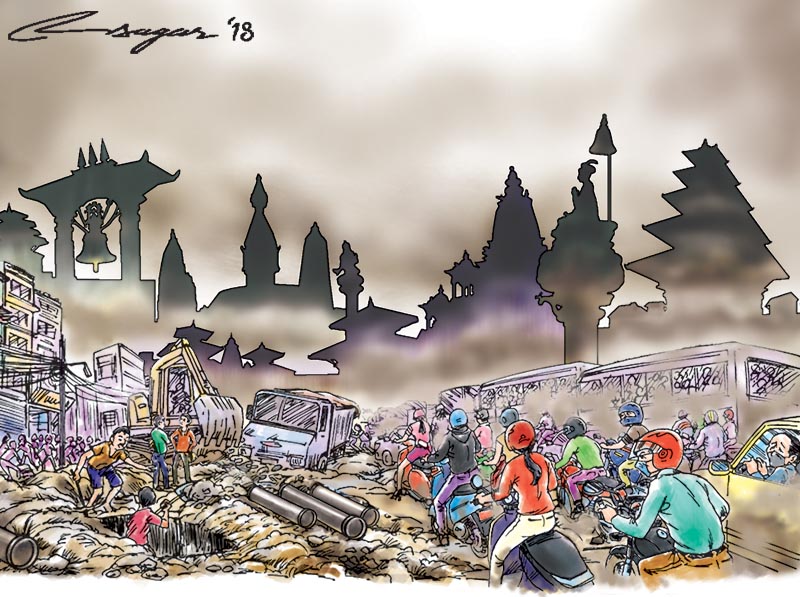Sustainable or smart cities: Change the discourse
The 11th goal of UN SDG deals with sustainable cities and communities. Sustainability incorporates measures against climate change so that people to policy makers could easily get rid of the treacherous practices
If sustainable development were achievable through sustainable infrastructure only, the most of the to-be-elected parties would not have glorified the term “smart” at the municipality and rural municipality levels. From the deep-down dunes to the mountains, “smart cities” just became the refrains during the elections held last year.
Flared with the frenzied smart city ideas, people adopted quite a lot of parametres, mostly, the internet kind of things to understand smart cities. Things like a card to pay the bill and travel and so on overwhelmed the Nepali psyche. It looked like smart cities are inevitable and they have to happen. However, little was done and conceptualised to assure the elegance of infrastructure and lifelines.
Sustainability concept simply disappeared from the politico-academic arena, and smart city dream inundated Nepal overnight. It should be carefully noted in Nepal that smart city would be an excellent idea if we had previously done zonation and wanted to create new urban spaces. However, Nepal, being a sparsely populated region state where planned settlements are not practised yet, may face grave challenges while creating smart cities at this moment. On the contrary, sustainability could be easily assured even in the built-up areas with little to no modifications at all. Kick-off should go along with the public infrastructure to be sustainable first, rather than jotting down the bullet points for the voluminous reports to formulate floating policies and commitment documents. The focus should be on cradle-to-grave analysis.
How the public infrastructures conjoin the triple bottom line (TBL) that is social, environmental and financial should be demarcated at this moment. That is beyond the imagination of smart cities.
When compared, sustainable cities’ longevity is incomparable to smart ones. The most striking aspect is: sustainability settles with resilience, resilience against the multi-hazards in both natural as well as anthropogenic hazard scales. The concept of city recyclability, downscaled toxicity, decommissioning of the public infrastructure to residential buildings, refurbishment, climate responsive and climate change responsive urban and rural settlements, high maintainability and low running cost, initial wise investment, prime focus on local
resources, durability, adaptation in design and deconstruction, encapsulation of social values, culture and practices throughout the service life of the public
infrastructures is a dire need of Nepal rather than just internet controlled livelihoods.
Among the 17 goals set by the United Nations for sustainable development, the 11th goal deals with sustainable cities and communities. Similarly, the 13th goal of “Agenda 2030” depicts climate action. Crucial to note here is sustainability incorporates the measures against climate change so that people to the could easily get rid of the treacherous practices that led to the severity of climate change.
A sustainable urban, as well as rural neighbourhood definitely and undoubtedly, should trap all the carbon emitted by the neighbourhood itself and let the green planet survive. Furthermore, sustainability brings prosperity. Time has come to switch the agenda of “Prosperous Nepal” into “Sustainable Nepal”. The happiness governed by sustainability would be superior to the happiness governed by prosperity. Actually, prosperity alone is an abstract term, mostly hinged to pecuniary issues and at times that may turn a deaf ear to the commonality and co-existence of all the tangible and intangible things on the earth.
Sustainability is often disused in Nepal. But government policies focus on sustainability but never concretise the holistic concept.
Sustainability cannot be achieved if practices are inscrutable and the same is happening in the surroundings nowadays.
In the high mountains, people are importing concrete from thousands of miles away to construct buildings and sell the wood at very low costs. The deficit is so high that the peoples’ earning is largely devoted to affording a home. Likewise, the government invests in infrastructure such as highway bridges without preparing for decommissioning as well as refurbishment strategy, and every time dismantling and replacing have become the tradition.
A few things are there, but the first things should be always at first. Kicking off with sustainability guidelines to public infrastructure and making all the guidelines mandatory would be an ideally instrumental step. Followed by the mandatory guidelines, assessment is needed regarding the materials and methods for sustainable structural and infrastructural construction strategies. In the meantime, the multi-hazards, their plenitude is well agreed in Nepal, should be inducted in the design and constructed to assure resilience alongside the sustainability.
The next step would be imparting the same sustainability concept to household to individual level so that even the livelihoods become sustainable. Obeying the sustainability measures portray ourselves as more dedicated to “Agenda 2030” too. To conclude, this is the right moment for Nepal to switch the dreams of “smart city” to “sustainable city”.
Gautam is a researcher in the multi-hazard sustainability of structures and lifelines






